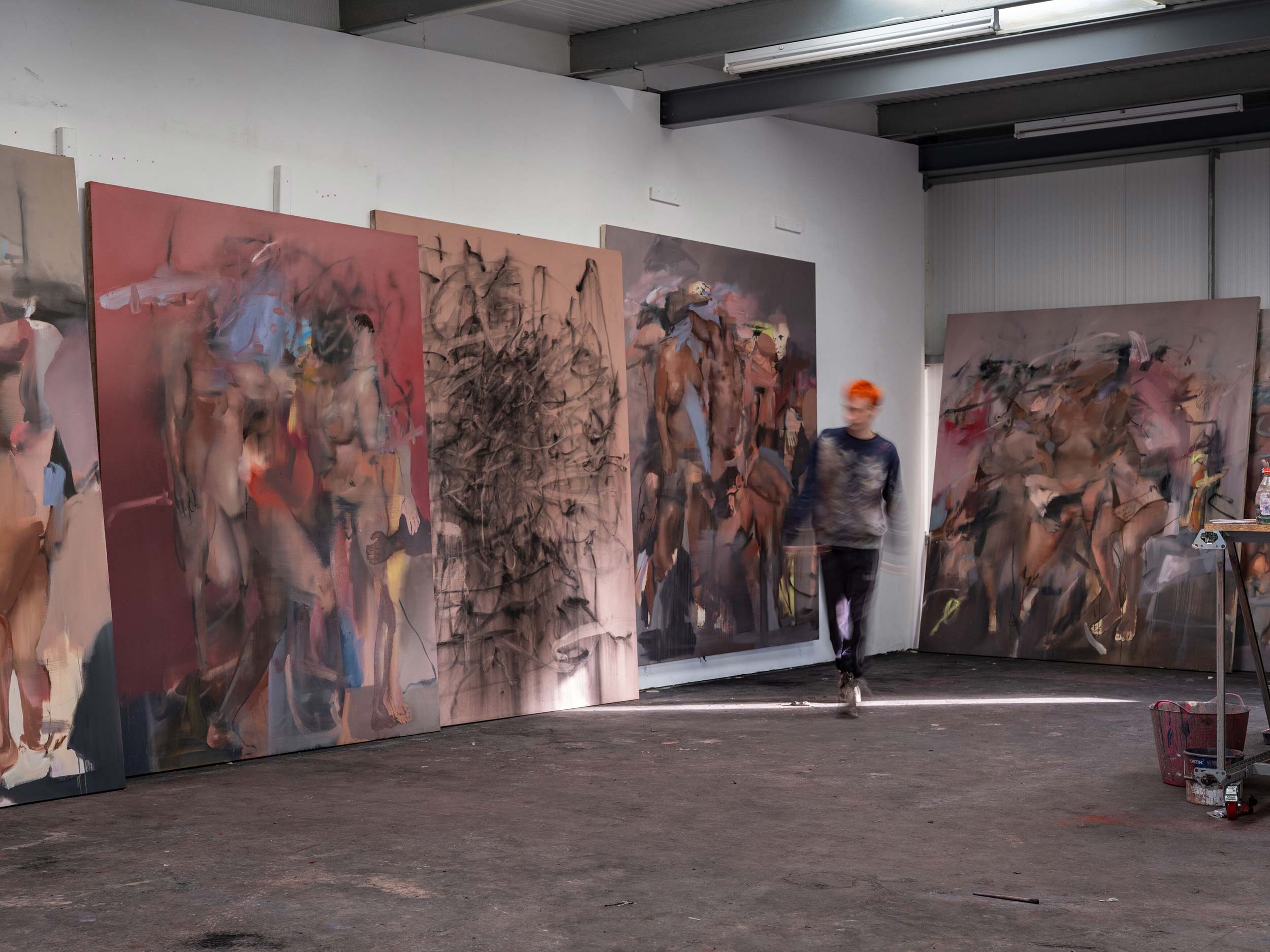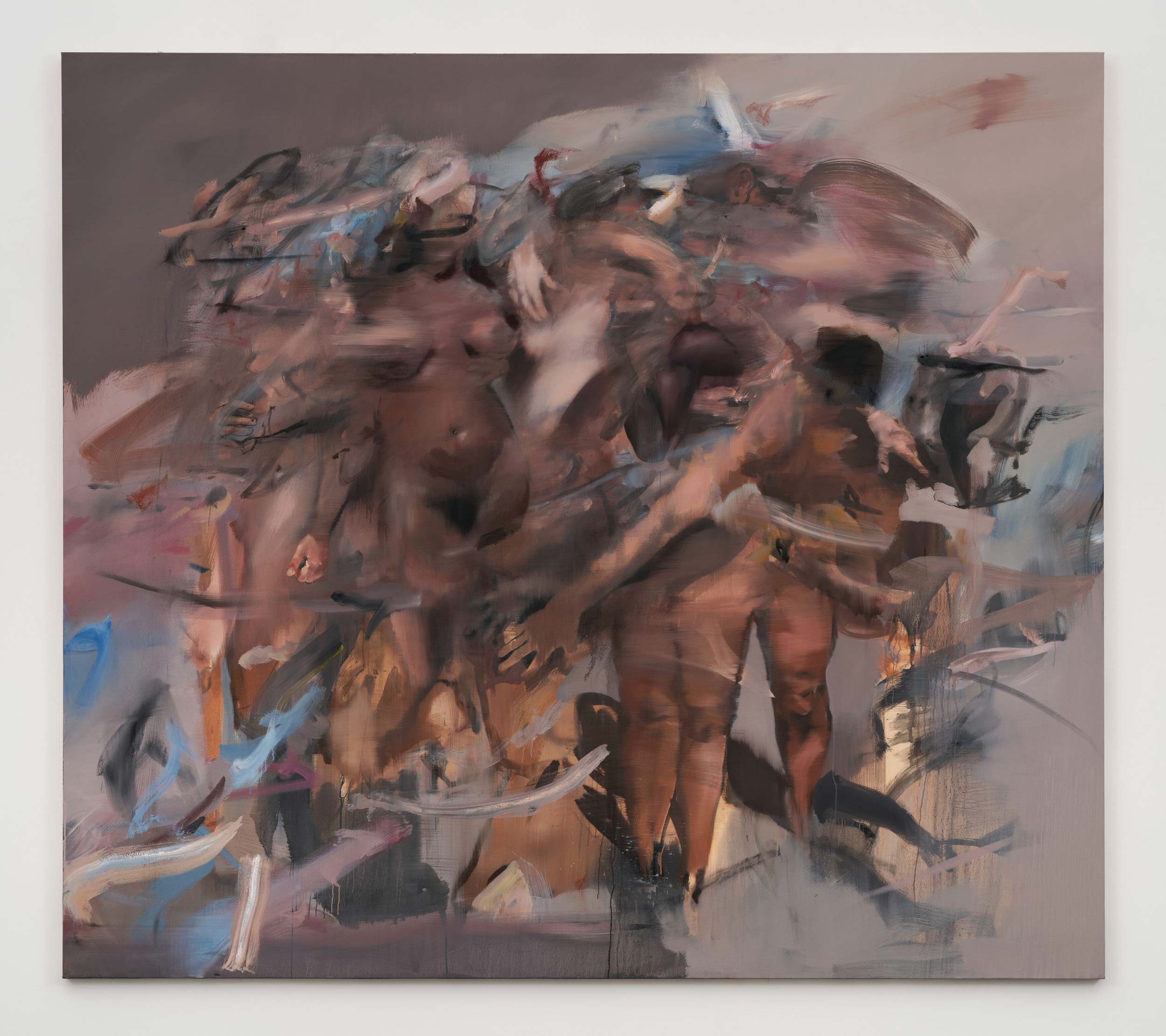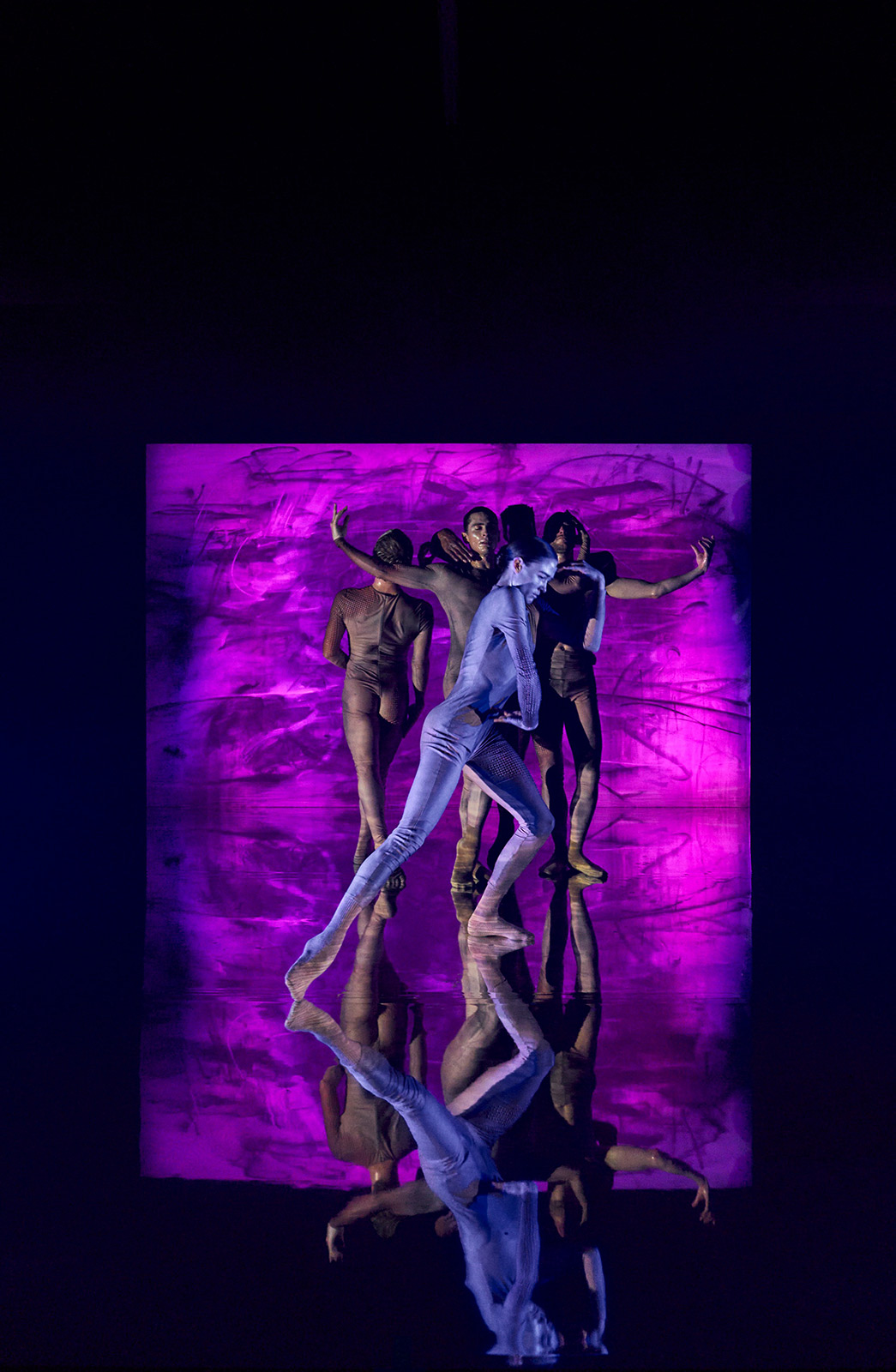Following his debut solo show in London, the British artist joins Document to discuss painting, performance, and his corporeal collaboration with choreographer Sharon Eyal
Six years ago, emerging British painter George Rouy attended a performance by the groundbreaking choreographer Sharon Eyal—and he was hooked. The two met backstage, formed a friendship, and eventually agreed to collaborate, following in the footsteps of great artist-choreographer collaborations like Isamu Noguchi and Martha Graham, Donald Judd and Lucinda Childs, and Daniel Arsham and Merce Cunningham. For three nights in February at Hauser & Wirth Downtown Los Angeles, Rouy and Eyal presented BODYSUIT, a collaborative performance where Rouy provided the music and scenography, 16Arlington designed the costumes, and Eyal the choreography. The movement unfolded like a live version of Rouy’s paintings.
A Rouy painting is like a frenzied flux of movement, conveying not just the physical features of bodies and faces, but also the emotion and energy beneath the surface that’s invisible to the naked eye. His brushstrokes render his subjects anonymous, blurring features, merging bodies, sometimes to the point of abstraction.
His solo exhibition at Hauser & Wirth Downtown Los Angeles, The Bleed, Part II, follows where Part I at Hauser & Wirth London took off. On view through June 1, 2025, Rouy’s first US solo exhibition with the gallery examines the process of stripping away elements, leaving his work somewhere along the blurred line between abstraction and figuration.
Document spoke to Rouy, who had just returned to his studio in Kent, England, about how he got his start, collaborating with Eyal, and the Delacroix painting he’s reinterpreting for an upcoming exhibition for Centre Pompidou Metz.
Ann Binlot: How are you doing?
George Rouy: I’m good — first proper day back to the studio today. Getting back into it. It’s always a bit lethargic, getting the body working again after nearly a month out.
Ann: How was your experience in LA?
George: My girlfriend’s family lives there. So we go there a bit for that. What was really nice was to finally show in America. Well, I’d had a show in New York a few years ago [at Nicola Vassell], but this felt like a step up and like a big moment for everyone, especially the work and myself. The work was ready for that audience, and was received really well, especially after doing the first part in London. And then to reiterate the body of work, it’s kind of the second part to it, I think it helped build that kind of momentum, and people could maybe draw comparisons between the show in London.
Ann: I was lucky enough to see the show in London. I was told you come from a family of creatives. How much did that influence you to become a painter?
George: We’re a family of creatives, but my mum and dad…so my dad is a retired hairdresser. My mum is creative, but [they] were never in the art world. I think what happened is my younger brother and sister decided to be painters too. I was the first person to do it, and then they’ve ended up doing it as well. What I think is really important is being able to have an environment where you can feel like you can pursue [art]. There was this pro-art kind of mentality. And you don’t have to go do a degree in law, for instance. There was always that kind of support there. My dad, he applied for art college when he was late teens, early 20s, and he didn’t get in. So I think he’s very proud that we’ve managed to do it.
Ann: Did you take art classes in high school? Did you go to museums? What led you to become an artist?
George: I was very fortunate to have art teachers that I really got on with and really helped me as well, like when I was at school, they let me stay during lunch times. So normally, [I’d] paint during lunch times and after school. I did that from the start of secondary school, I did after school, just stayed in the art room for that. That was amazing, to have that support. I always say that I wasn’t the most academic of kids, but having people to have faith that you can actually set foundations to be an artist was a massive lifeline. Because without that, who knows what I’d be doing?
Ann: What painters influenced you early on? I see a lot of Bacon’s influence in your work.
George: You know what? It’s not really — Bacon never really did it. When I was really young, Jenny Saville, she was a massive one. I also loved Chris Ofili, a lot of these British proper painters from England. I loved Cecily Brown. When I was younger, [I was] into more of the technical painting, and then that got more naive, and then went back into it. It changes all the time. You have Jenny Saville on one end, Cecily Brown on the other. And you’ve got people like Bacon, Freud. It’s almost generational. For a while I was trying to navigate: What level do I sit on in relation to that? It changes all the time. What’s amazing about Bacon is his ability to focus on the psychological aspects of the body, and strip away anything other than just purely the room or the sense that there is a viewer, a new object or the figure. There is this very direct link, so I can see why there’s that reference to Bacon, because of how stripped back it is and how focused it is on the figure. I really feel like how the photograph has influenced my work, and I think of people like Jenny Saville as well, and how the photograph was very much in her work. But then on the other extreme, you’ve got people like, you know, Cecily Brown, who, though she works for photographs, they’re so removed from that.
Ann: Tell me about your process. Do you paint from live models, or do you use photos, a combination, or your imagination?
George: It’s not so much live models. I used to when I was at college. I used to do a lot of life drawing, and then moved away from that. I use a lot of photographs, a lot of found imagery that I collage on Photoshop. You can have one catalyst for an image that gets slowly, slowly reduced, reduced, reduced, through the process of making and through the grinder of making the work, that there is this familiarity to a piece. There’s this essence of the subject, or at least there’s a DNA to it, but it’s so far from that original thing.
Ann: Would you say you’re deconstructing the human form, or are you building on to it?
George: I start with quite a clear depiction of the body when I start the paintings, and then as they go through, they become more and more interrupted. That’s the intrusive part of painting, I think, is understanding what parts you want to keep and which parts you want to set back or not have the eye catch. It’s about being able to kind of stand with a painting and just take it in, without it feeling like you have to decode it, although the works, I think you do have to decode a little bit, but they also should feel like they can just exist and you can just look at them.
Ann: I see a lot of tension between chaos and control in your works. How do you channel what is going on with you personally and what’s going on in the world into that?
George: All these things are kind of allowed to just enter. You’re not trying to define it in thought, and you’re not trying to define it in text, even. It’s purely a way in which I process it and it does feed out into the work. It has that anxiety, it has the tension, sometimes as a lightness, you know? What’s wonderful about painting and being in a place to be able to express so much all the time is that these subtle shifts happen throughout time.
Ann: Yeah, you let your intuition guide you.
George: Intuition is such a vague thing to say, but it’s such a human and important thing, because it’s applied by what we know and you know what we don’t as well.
Ann: What drew you to dance?
George: Only Sharon’s work. I fell in love with her work, and it was never anything other than that. I’ve seen a few dances, well, quite a few dances after that, and nothing took me as much. What’s amazing about Sharon’s work is that it was doing the things that I wanted to achieve. It’s incredibly potent in the way that it comes across. There is this emotion, and there is this bodily aspect to the work. And again, it’s intuitive. There is no narrative, there is no sense of resolve. Let’s say there is no ending. It’s just forever in that state.
Ann: Would you say discovering her work six years ago changed your practice?
George: I must have been 25 and then I think I was going for a pivotal moment anyway with the work. I was going through a transitional moment at the time. I was trying to set up the next five years and set up a project in terms of, like, where I wanted the work to be, and I knew that it was going to take about five years. And now we’re having this conversation. I think I’m in a place where I’ve achieved that, but when I was 25 there was no way I was doing the work I wanted to do, or could realize the work I wanted to do. So, meeting Sharon and seeing a lot of her work over that period of time reinforced clarity in how I moved forward.
Ann: What’s your collaboration process like?
George: Sharon’s a very, incredibly unique person in the way that she is. So we send each other voice notes, but then I normally send her music. The best bit about this collaboration is that we didn’t really speak too much about it. We were in the studio, and I had the music, and we would say that’s good, that’s not and, I go away, work on a bit more, and then we come back, and then I’d feel it. She’d feel it. It felt very natural, because it’s kind of how we both work. It’s just you do it, and you keep working. Through doing, it kind of carves out, and it’s there. So it was not too much talking. The talking came afterwards, with the logistics, but that was with the team.
Ann: Do you feel like you can express certain things through dance, through the actual performance, that you can’t through your painting? And how do you feel they complement one another?
George: The thing about the dance is that there is this energy to it, and there is a physicality, and there’s the sweat, and there’s this mortality to the dancers as well. You know that they are human. So there’s something very incredible when you watch your studio do anything live. I don’t think you’re ever going to be able to replicate that in a painting. The symmetry is in the fact that they are both practices… and there is a relationship. When the viewer or the audience sees the work, they can sense their own body, and that is very important.
Ann: What were important qualities for the 16Arlington bodysuits to have? Was it the color or the way they moved, the way the light reflected on them? Because the light is a character in itself.
George: The light is definitely a character. I think the key was that they felt like skin to a certain extent, or felt neutral, and that there is a sense that they’re not too much of a costume. We want to keep it as minimal as possible, but without it feeling nude, yeah, because there’s that sense as well. So they needed to feel like there was just enough. With that, we stripped them right back. Then I went and applied the kind of the finishing to them that just distorted or emphasized certain parts of the figure a little bit, and just gave it that extra texture that I think it needed when seeing it under the light. What’s beautiful about the costumes is that there are these creases and wrinkles in them.
Ann: You’re Hauser & Wirth’s youngest artist. I imagine that is a lot of pressure.
George: It feels incredibly normal when I’m in the studio and in my own house. I don’t live in London, so I have a very normal life. It’s only when you get to a show or there’s this outward perspective of what I am is different. What I would say the most amazing part of it has been is I kind of had a feeling—me and Hannah—before we were working out Hauser, I had a sense that the work was nearly ready for that next stage, or that next jump to to a place like Hauser, and I felt like having that platform, and I could sense it in the studio. And I said to Hannah at the time, I think we should start thinking about that conversation because at some point the work’s going to do this, and that’s going to plateau. But there’s that sense that you want to get it when it’s energized. There is this sense that it feels like it’s the right time. So when we spoke to Hauser, and then the conversations opened up with Hauser, I think being able for them to facilitate two large shows in very important parts of the year in different locations, has been a brilliant first step with working with them and doing BODYSUIT as well.
Ann: What’s next for you? What are you working on?
George: The next thing I’m working on is a project with the Louvre and Pompidou-Metz in Metz [,France]. They’re doing a large show of artists doing copies or versions of paintings from the Louvre, so it’s going to be quite an incredible show. The painting I chose is the Massacre at Chios [by Eugéne Delacroix], which is going to be an amazing one to do.



























